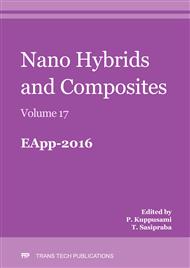p.24
p.31
p.37
p.44
p.55
p.62
p.72
p.79
p.88
Establishment of Carbo-Chlorination Facility and the Preparation of High Pure Hafnium Chloride for Space Grade Applications
Abstract:
In view of the increase in demand of atomic energy and also dynamic increase in the number of space flights in our country, the limitation shown by developed countries on supply of hafnium metal for strategic applications has made our country to develop indigenously for its sustainability. The technology for the setting up of the hafnium pilot plant has been initiated by C-MET Hyderabad in collaboration with VSSC (ISRO) in order to compete with rest of the world. India has a good reserve of hafnium containing zircon sand where the hafnium containing zirconium is in the range of 1:50. A good quantity of zircon sand is available in mineral rich beach sands of India. Nuclear Fuel Complex, Hyderabad has commercial plant to produce nuclear grade zirconium for producing atomic energy. Zirconium scrub raffinate solution a by-product of NFC, Hyderabad containing decent amount of hafnium and zirconium is the raw material used for developing NIOBHAT 101 alloy such as niobium and hafnium for space grade applications and nuclear reactor control rods as the hafnium is having high neutron absorbing capacity. The major steps involved are separation of zirconium and purification of hafnium by solvent extraction, preparation of hafnium oxide, feed preparation and chlorination, reduction of hafnium chloride and separation of magnesium by vacuum distillation and sponge handling. In this regard Briquetting and Carbo-Chlorination processes are very vital because the reactivity of oxides depends on the calcination and coking conditions keeping a side precipitation conditions. The phase purity and chemical purity of hafnium chloride has immense influence on the following process namely, Kroll’s Reduction. This paper enumerates the experiments conducted in obtaining phase pure hafnium chloride. The data leading to optimised process parameters for the production of phase pure material has been presented.
Info:
Periodical:
Pages:
55-61
Citation:
Online since:
August 2017
Authors:
Keywords:
Price:
Сopyright:
© 2017 Trans Tech Publications Ltd. All Rights Reserved
Share:
Citation:


